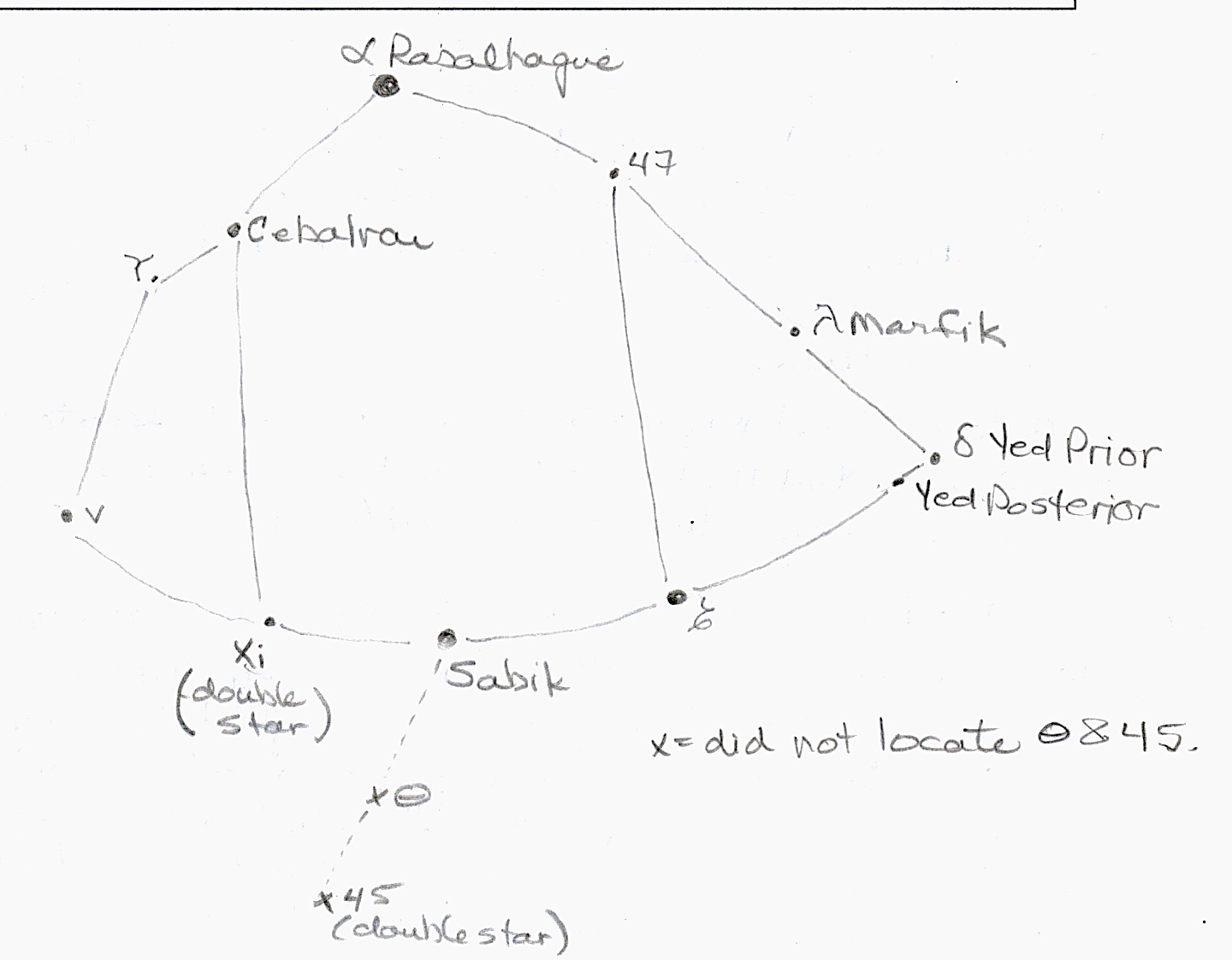Constellation: Aquila, Boötes, Capricornus, Cygnus, Delphinus, Lyra, Ophiuchus, Scorpius
Asterism: Coathanger / Collinder 699 / Brocchi's Cluster, Teapot
Messier Object: M7 (Ptolemy Cluster), M8 (Lagoon Nebula), M13 (Hercules Cluster)
Planet: Jupiter, Saturn
Stars: Albireo, α Cap1 + α Cap2, Arcturus, Fomalhaut, Vega
Located, Not Observed: Hercules, Corona Borealis
Location: Site 13, Kejimkujik National Park & National Historic Site
Date: 2017-07-19/20
Time: 9:45 PM - 10:45 PM + 1:25 AM - 2:25 AM
Instrument: Visual + Binoculars 10x30 IS + Binoculars 15x70
Magnification: x10 + x15
Transparency: Good (3) - Very Good (4)
Seeing: Good (3) - Very Good (4)
Temperature: 15º C
The earlier session ended in fog. The second session had near perfect clear skies, no wind.
Jupiter
Time: 9:51 PM ADT
Instrument: Visual
Jupiter was located below Arcturus, halfway to the horizon.
Scorpius
Time: 1:30 AM
Instrument: Visual
S&T Chart Ref: 56, 58, J
Scorpius at this time of morning was mostly below the horizon. Could still see Antares, Delta and Graffias easily and perhaps π but the rest were out of observing range.
| Capricornus Time: 1:40 AM Temperature: 15º C Instrument: Visual + Binoculars 10x30 IS S&T Chart Reference: 66, 68, 87 Sitting on Slapfoot Beach, Capricornus was right in front of us. The major stars of the constellation were easily identified, and α Cap1 + α Cap2 were easily identified in the binoculars. |
Lyra Time: 1:46 AM |
| M8 (Lagoon Nebula) Time: 1:35 AM Instrument: Binoculars 10x30 IS S&T Chart Reference: 667, 69, I Was easily able to locate the grey smudge that had the line of stars below it. Not as well seen as in previous observations but easily identified nonetheless. |
M7 (Ptolemy Cluster) Time: 1:50 AM Instrument: Binoculars 10x30 IS S&T Chart Reference: 58, 67, 69, I The fog earlier in the evening had cleared off. Although the Teapot was low on the horizon, I was able to locate M7. The 5 brightest stars could be seen with slight nebulosity; the inner stars could be seen in the centre area but there were not very bright. |
|
Ophiuchus No wind and only the occasional cloud. Amazed at its size!! I was looking at Scorpius (visually) and noticed an arc of 4 stars above. Using SkySafariPro, I came to realize it was Ophiuchus. What a pleasant surprise! Unexpected discovery! Once all the baseline stars in the curve were identified, I then began the search upwards. WOW! It was huge in the night sky! The Teapot was very small by comparison. Note 1: When I used SkySafariPro, I also discovered that one of the "stars" in the arc was not a star but rather it was Saturn. Note 2: used my 10x30 IS binoculars to locate both Yed Prior and Yed Posterior. Couldn't see them as 2 stars using naked eye due to sky conditions. |
 |
|
Aquila |
Boötes
|
Coathanger / Collinder 399
Time: 2:05 AM
Instrument: Visual + Binoculars 10x30 IS
S&T Chart Reference: 65
After locating Cygnus, I put up my binocs to where I thought it would be - et voilà! First attempt to locate it. All 10 stars easily seen. Went back to Cygnus to locate Albireo to use it as the start point to locate the Coathanger. Put my binocs up to find it then went 45º downwards and located it again. Tony Schellinck taught me well!
Delphinus
Time: 2:10 AM
Instrument: Visual
S&T Chart Reference: 64
Located Delphinus visually throughout this session. All 5 stars could be seen. Didn't attempt to use binoculars.
M13 (Hercules Cluster)
Time: not recorded
Instrument: Binoculars, 10x30 IS
S&T Chart Reference: 52, 54
Used Corona Borealis to locate M13 with binoculars. Grey fuzzy was easily seen between η Hercules and ζ Hercules.
After a short sleep we were once again the go getting ready to take down camp when Jerry noticed the waning crescent Moon. Almost missed it against the clear blue sky. Read more about it at Explore the Moon (Binocular) - July 20, 2017.